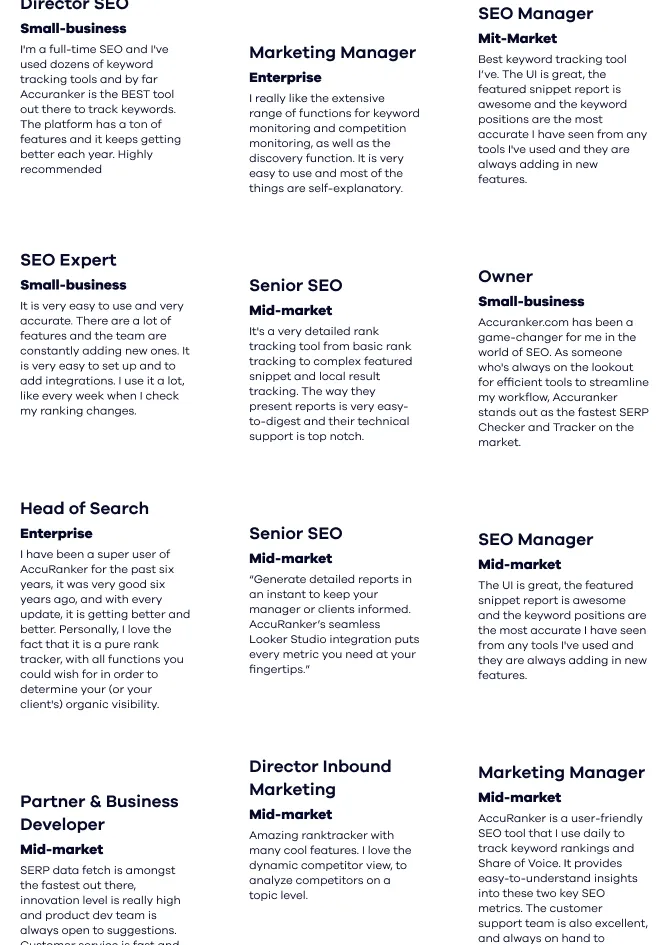
Maximise Your Content ROI with the Innovative SEO Strategy Driving Millions of Hits to HubSpot’s Blog
April 6, 2018
Maximise Your Content ROI with the Innovative SEO Strategy Driving Millions of Hits to HubSpot’s Blog
See how HubSpot created and implemented their own Innovative SEO Strategy using AccuRanker … and how you can get the same results!
Download the Guide Now!
If you have heard of HubSpot’s Topic Cluster SEO Strategy but you’re not sure how to implement it on your own site, or how to track your Content ROI, then read on!
Discover how HubSpot implemented their own SEO strategy and download our step by step guide on how you can implement the intelligent architecture on your own site, whilst tracking the impact and ROI of your content with AccuRanker.
2017 was the year of the “Topic Cluster”, HubSpot’s revolutionary new way of organising website pages to make the most of internal Pagerank and maximise SEO value.
This shake-up in the way HubSpot structured their content was a response to the changes in the way people search and how search results are served.
HubSpot has championed this new model as the next evolution of SEO. It’s an approach that was born not just from theory – but as a solution to a problem that HubSpot faced themselves.
Before anyone had even uttered the words “Topic Clusters”, HubSpot’s SEO Team were busy behind the scenes assessing and implementing this more subject-matter focused website architecture, trialling their own site as evidence of the validity of their new approach to website content structure.
Rank Tracking & Topics
To facilitate and track this re-organisation, HubSpot needed a keyword ranking tool with speed, agility and reliable accurate performance. They launched the drive to re-organise their own content using AccuRanker as their primary keyword ranking tool.
It was absolutely essential for the HubSpot SEO team that they had a tool that was able to track and monitor the impact of their restructuring and monitor their progress at every stage.
Padraig O’Connor
Acquisition & SEO Manager at HubSpot, LinkedIn
Things happen quickly at HubSpot and we needed a tool could keep up with our fast paced nature.
We loved AccuRanker’s ability to refresh the position of keywords in a particular cluster group at any time. AccuRanker gives our SEO team the data we need to make the right decisions.
Like any SEO endeavour it takes time to see results, and amongst periods of growth, decline and ranking fluctuations it was essential for the HubSpot SEO team to have the inside track on how their Topic Clusters, as the primary indicators of their new SEO strategy, were performing.
“There is no “standard x + y = z when it comes to SEO” but by tracking their keywords and topic cluster related terms, the SEO team were able to get close to understanding the causality behind successful and unsuccessful SEO strategies they were trialling.
By using the cutting edge features available with AccuRanker they were able to monitor the health of their “Topic Clusters” and crucially – able to adjust and refine their strategy along the way according to the results they were seeing.
In SEO the Goalposts Move
The restructure of the blog was the final excuse they needed to start the wheels turning to enact the new approach that had long been advocated by HubSpot’s Director of Acquisition Matthew Howells-Barby.
Whilst changes in behaviour are the main drivers behind the Topic Cluster approach, the reasons behind the need for change are much wider.
More more more
There was a period of time and a corresponding school of thought that led marketers to believe that all they needed to rank higher was more content. However, piling more content onto already poor existing site architecture doesn’t help search engines to find and rank content.
The problem turned out not to be lack of content, but actually, the way in which content strategies were being developed and organized.
Matthew Howells-Barby
Director of Acquisition at HubSpot, LinkedIn
When you’re producing content at the rate that HubSpot does, information architecture is incredibly important. Building out an editorial calendar that aligns to a topic cluster model isn’t just better for organic search, but it makes the entire content ideation and creation process much easier.
Conversations with Google
In the last few years, there has been a massive shift in how people search for what they want online. Search queries are more conversational, full sentences with a few keywords thrown in, specifics refined on the 2nd or 3rd attempt.
In response, search algorithms have become more complex with numerous updates focused on understanding and interpreting these queries. The 2013 Hummingbird rollout began analysing phrases instead of just singular keywords.
It is no longer enough to focus on your top 10 – 20 keywords, there are now hundreds or thousands of semantically related variations that are searched for within a certain area. The HubSpot Pillar/Cluster model organises your site into topics and clusters to better serve searchers. Tracking and ranking for a handful of keywords is no longer enough.
Legacy Content
HubSpot as a company has seen tremendous growth in recent years, and this growth has been reflected in the size and amount of content on its website.
The main HubSpot blog is over ten years old, and the team faced a common problem for sites that have been running for more than a few years – that of legacy content. Huge numbers of web pages spread across blog subdomains with no coherent or cohesive linking structure.
Brittany Chin
Customer Marketing at HubSpot, LinkedIn
At HubSpot we noticed that we had a lot of content, about a lot of topics, but we were having a hard time organizing and prioritizing where to focus our efforts next.
Reorganizing our content into Topic Clusters allowed us to not only give all of our well performing content an extra boost in the search results, but also audit our existing content and revamp our content strategy.
Very few companies begin a blog with a plan of how it will relate to the overall site architecture and how to maximise the linking structure for SEO gains or even how they will measure its ROI. Planning this from day one has major advantages, you can reap the rewards of the Pillar/Cluster strategy from the start.
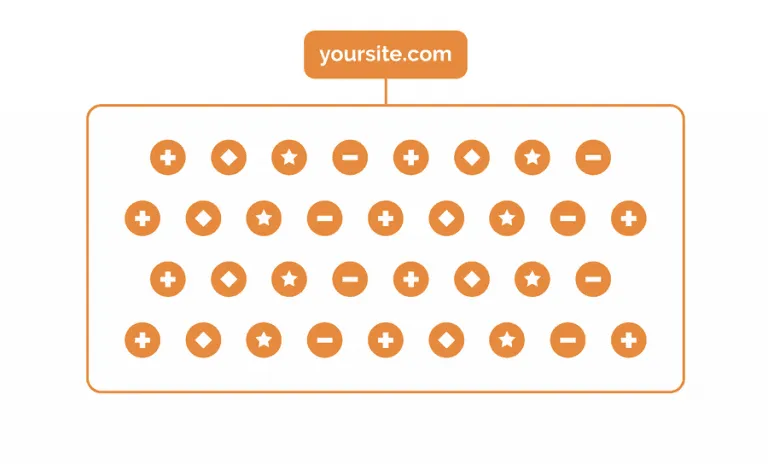
Legacy content without structure
As a company such as HubSpot grows, and it’s blog along with it, more and more content is added, that, while inherently valuable in terms of informing readers, ultimately lacks direction and cohesion, compounding the problem and not making use of the internal Pagerank that the site has built up over time.
Patchy Linking
In the scenario above, linking can be ad hoc and patchy, it’s hit and miss as to whether the reader can find what they want and you are spreading your authority randomly rather than being more strategic and linking out to the content you want to push up on search engine results pages.
As well as losing out on potential organic traffic due to poor or non-existent internal linking, content heavy sites, particularly those with large back catalogues have many pages covering the same or similar subjects. These pages end up directly competing with each other on search engines.
3 Blogs - 12000 URLs
As the HubSpot team and it’s blog had grown they had learnt along the way what worked and didn’t, but the approach was inconsistent and there was no clear web holding it all together.
The potential for such a large body of work was huge.
So HubSpot found itself in a tricky situation ….
TEN YEARS worth of valuable, relevant content.
No structure.
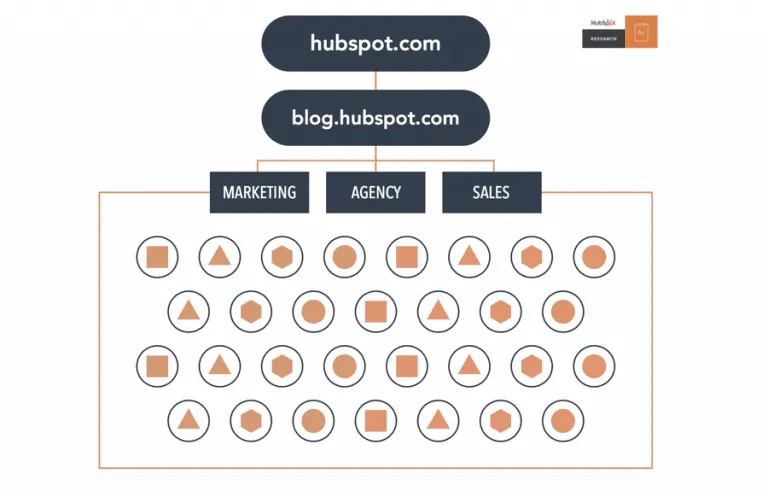
HubSpot Blog Architecture – Pre-Topic Clusters
The prospect of organising such a massive amount of content would be daunting to say the least …
But not easily deterred, the team decided to use the opportunity to consider how they could tackle overall architectural issues that had arisen over the years in relation to the sheer volume of content present on their site.
The Challenge for Hubspot
The HubSpot Team really had some big questions at the start of this massive undertaking that fell into four main areas
Content:
- How do we make the blog back catalogue more user and search friendly?
- How can we make our use of tags and filters more intentional?
- How can we ensure the quality of the information that we publish?
- How can we link the insights from the SEO team up with the content that is being produced?
Architecture:
- How do we create a site architecture that benefits our website users and ourselves?
- How do we set up the pillar/cluster architecture behind the scenes?
- How can we create a structure that will enable us to scale when working with vast amounts of content?
- How to devise a uniform linking structure that will streamline content production and linking procedures going forwards.
SEO:
- What is the most effective way to monitor rankings at a topic level?
- How can we make better use of our crawl budget?
- How can we make better use of our internal Pagerank?
Impact
The team had some idea of what they expected to see from the application of their strategy but were aware that in a project of this scale that they could be in for surprise or two.
What they expected to see from the implementation of the new architecture included:
- Increased rankings on search engine result pages and a rise in organic traffic.
- The ability to spot content gaps much easier and quicker.
- Avoid keyword cannibalisation, having multiple blog posts ranking for the same keywords but none ranking well.
- Increased “Share of Voice”
- Increased backlinks to both the pillar pieces and the cluster content over time.
- Combat content saturation and overwhelm
- Raise quality and authority by improving existing pieces using the topic cluster approach to see what’s working and what needs more attention.
Despite having a huge website, HubSpot’s SEO team is small yet capable – so it was essential that they were armed with the right tool. The combination of intelligent, advanced in-house SEO expertise and cutting-edge rank tracking capabilities create a partnership that delivers real results. To learn more you can visit HubSpot’s SEO Training section.
AccuRanker: Topic Clusters and Rank Tracking
So the HubSpot SEO team set about reimagining the foundations on which they would build their Content Strategy to capture organic search traffic across a large number of relevant and semantically related keywords.
Following a full audit of the content on their blog, they grouped the content by topic, and then segmented along “cluster lines”. For more info and best practice on how to achieve this then you can download our guide here.
Once the overall structure was confirmed with the relevant pillar pages, corresponding cluster content and confirmed internal linking structure, the next stage was to allocate the relevant primary keywords and semantically related keywords to each cluster within AccuRanker.
Absolute Accuracy
The HubSpot SEO team knew from the outset that a vital element of a successful Topic Cluster strategy would be the ability to track the impact of what they were doing.
Without an accurate reliable way of tracking their results, they knew there was no way of evaluating whether their assumptions and their innovative new strategy, was having an impact.
It was also essential for the team that they collaborated with a tool that was able to process large volumes of data, that was able to deliver results on demand, and that had a reputation for serving reliable results.
When working with such a large volume of data – the results of which will be informing and assisting decisions on content ROI and strategy for the market leaders in Inbound Market and Sales Software, there was no room for doubt concerning the validity of their data.
Segmenting and filtering keywords for Topic Clusters
HubSpot’s SEO team allocated each Topic Cluster its own set of keywords, within the hierarchy of keywords. Each keyword was tagged with the respective cluster it belonged to.
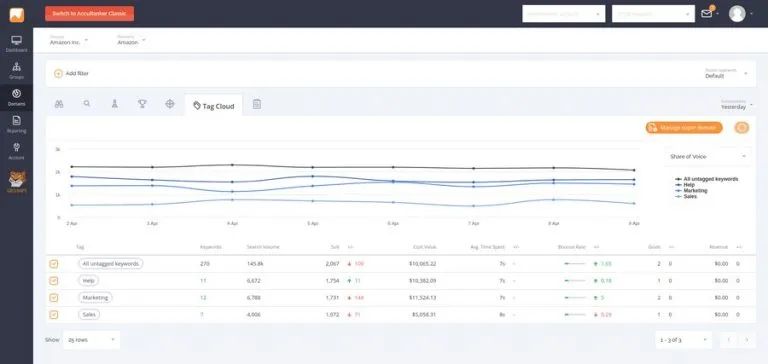
AccuRanker - Tag Cloud Feature
Using the categories, tags and star mark functions in AccuRanker to segment the keywords according to the clusters, the team were able to set up their views within the system to track and monitor the fluctuations and overall progress of their primary keywords.
Each cluster would be allocated a “head” keyword which would be closely monitored.
By doing this they were able to get a picture of the “health” of each cluster and exactly how they were performing and effectively monitor the traffic at a topic level.
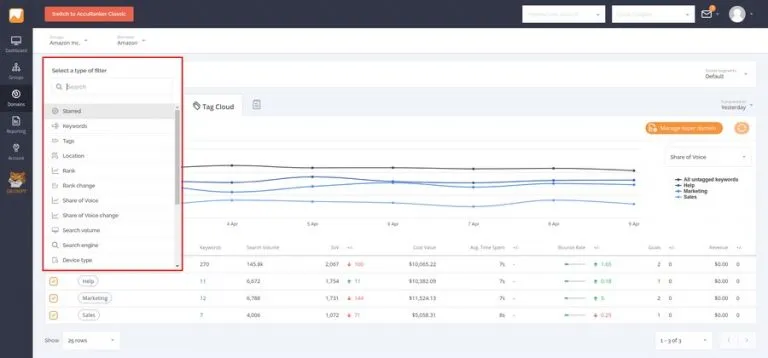
AccuRanker Filtering and Segmentation Features
The filtering and segmentation features are crucial for companies that monitor their Content ROI on a daily basis and need to see the impact of their strategies fast. Companies such as Kinsta that rely on the data from AccuRanker to really drive their own and their clients strategies.
Brian Jackson
Director of Inbound Marketing at Kinsta, LinkedIn
AccuRanker does a lot more than just track the rankings of keywords. One of the driving factors for me using their tool since day one is the ability to more easily crunch and filter keyword data. Complex tasks such as segmenting ranking results and correlating it with on-page content or structural changes are a breeze.
This helps to instantly pinpoint drops or spikes in traffic and other sitewide changes such as gaining those coveted featured snippets in SERPs; all without ever having to open Excel.
AccuRanker makes it easy to see what my competition is doing, where I succeeded and failed, and then make smart and data-driven decisions to achieve rankings that perhaps I originally thought were out of reach.
I have used AccuRanker for over three years, across three companies.
It’s one of the tools as an SEO and marketer that I simply can’t live without. Having the powerful ability to slice and dice ranking data is the only way one can keep up with and understand all the crazy changes happening weekly in SERPs.
SERP Features
The capacity to view SERP features was another area that was of particular importance to the HubSpot SEO team. By tracking when they were being found in Featured Snippets for example they were able to further quantify the validity of the linking structure.
Advanced features such as the Live Search, historical data, goal setting functions gave the team the possibility to further drill down into the results and the capacity to hyper-focus on different areas of performance.
This ability to effectively hold up a magnifying glass to areas that require in-depth analysis, certain clusters, or semantically linked non-primary keywords, without having to sift through mountains of data first has proved invaluable for the team in how it coordinates with and informs other departments within HubSpot.
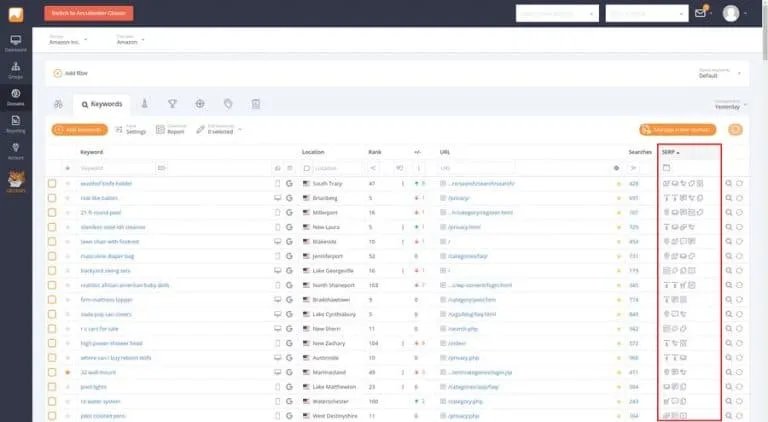
Henrik Jørgensen
CEO AccuRanker, LinkedIn
We were thrilled to work with HubSpot on the implementation of this groundbreaking new approach to content and site structure.
The powerful filtering, segmentation and tagging systems in AccuRanker enable teams like HubSpot to dig deep into their data and extract exactly the analysis and metrics the teams need to assess and guide their progress on an ongoing basis.
The team really explored all of the features AccuRanker has to offer and their investment paid off with the knowledge and insight they were able to share with the rest of the organisation.
Link between SEO insights and content production
The SEO team quickly realised that by tracking the health of their Topic Clusters they were able to surface invaluable information to the content team about which topics required more content, which needed work and which were already saturated.
Able to now swiftly identify what was high priority, they could assess which were not performing well and required action improve their rankings. Content gaps became much more visible.
It was also possible to refresh older legacy content with updates keyword insights, raising the value of these pieces in SEO terms and giving the content’s ROI a boost.
Sharing the wealth
For the SEO team at HubSpot one of the stand out features of AccuRanker for them was the reporting. The ability to customise and schedule reports on their Topic Clusters provided them with a fast, accurate and efficient way of disseminating the information to both other members of the SEO team, and other departments.
Removing the need to wade through lots of complex and context-less data vastly speeds up the process of feeding back the insights and analysis being seen by the SEO team.
Progress reporting
As well as feedback on specific areas to inform content production the reporting function is also central to staged progress report to inform more strategic high-level decision.
Victor Pan
Senior Search Marketing Manager at HubSpot, LinkedIn
HubSpot needs to be at the forefront - without a tool such as AccuRanker we will always be playing catch up.
Key findings: What has HubSpot learned so far?
So – as with any SEO strategy endeavour, patience is necessary. However, after a solid few months of monitoring, tracking and analysing their results with AccuRanker, HubSpot already have some vital insights on the overall Topic Cluster strategy and how it has impacted their own site’s traffic and performance.
Intelligent architecture gifts relevance
The architecture redesign overall speaks to quality. The ability to focus on what readers and customers find useful – insights backed up by accurate keyword performance data – is customer-focused Inbound Marketing at it’s best.
One of the most interesting findings seen so far is that when a page is cleansed of all existing links internally and the foundations are clear, the impact of the new internal linking structure has the maximum impact – noticeably more so than when existing links are left in place.
Structured, intelligent internal linking not only pleases Google, it pleases the searcher – the ultimate authority!
An intelligent linking structure enables the user to pick their own journey through your site. It gives people relevance, not just more.
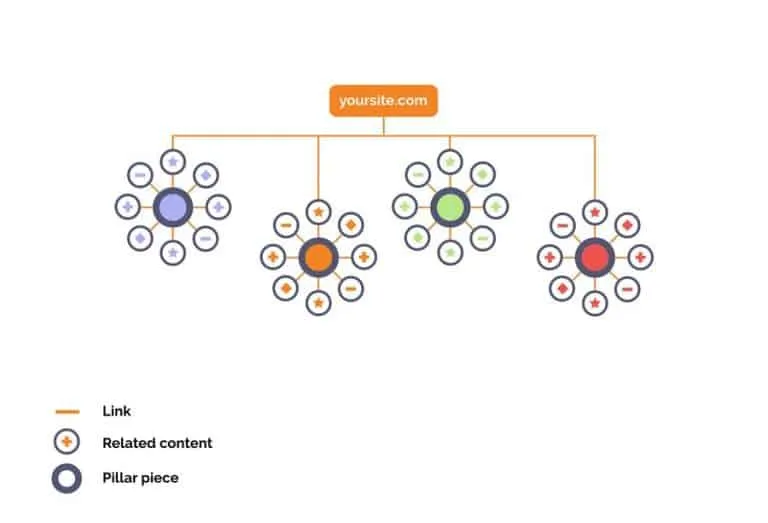
Topic Clusters and Intelligent Architecture
It also tackles issues of content saturation, which is more apparent with the SEO and Marketing industries than many others because we are the content creators.
Declutter builds trust
The new approach has enabled Hubspot overall to streamline the content that they have and that they put out. The approach has also crossed over to their email marketing where they have attempted to declutter and reduce the number of emails that are being sent.
With a renewed focus on relevant content you reduce the risk of overstretching your “trust” with users.
Better quality of information can go some way to making up for the excessive quantity of the past.
Linking is On-Page SEO 101 but the discernible difference here is the pillar page. HubSpot’s reframing of this basic SEO principle facilitates search intent.
It is preemptive, intelligent, user-oriented SEO optimization of content on a massive scale.
Rank tracking is essential to scale
The changes to the architecture foundations are built solidly – with the intention of scale.
The capacity to track from the bottom up, as content production grows and the strategy begins to undulate outwards is paramount.
The historical rank tracking of Cluster Health will form a central tenet of a cohesive framework, to which any number of new topic clusters can be added.
So what's next?
HubSpot is already seeing big results.
In a six month period from August 2017 to February 2018, they have seen an increase in their average rank from position 50 to position 24.
The positive impact of their new content strategy can also clearly be seen in the Share of Voice figures for the same period, where they are dominating the marketplace for their Topic Cluster keywords over their competitors.
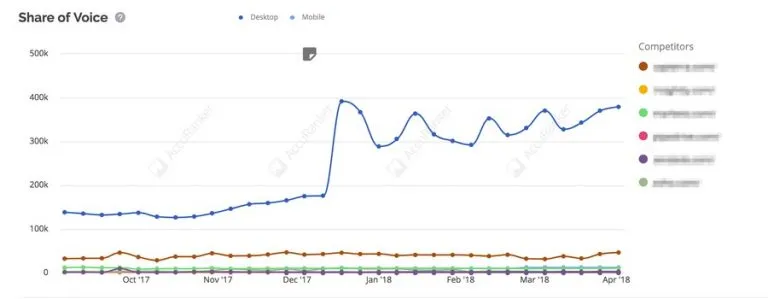
HubSpot – Share of Voice Graph for August 2017 to February 2018
After seeing such success with this SEO strategy on the English blog, HubSpot rolled it out for their international blogs last December.
HuSspot believes that these positive results are only the tip of the iceberg and that the real wins are yet to come.
Have you implemented the topic cluster architecture on your site … or perhaps you are considering it?
Download our free White Paper “A Step by Step Guide on How to Implement HubSpot’s Topic Cluster Strategy Using AccuRanker ” to see how to structure your account to replicate the Topic Cluster structure on your site.
Are you already tracking your Topic Clusters with AccuRanker?
Drop us a line into the comments before and let us know what results you are seeing … or if you have any questions about how to best structure your data using AccuRanker then let us know.
Related blog posts

Track Your LLM Performance with AccuLLM
You can now track ChatGPT, Perplexity, AI Overview, and AI mode with AccuLLM. Learn how we help you monitor your LLM performance.
20 October 2025Google Num 100 Update
19 September 2025
How LLMs Change Traditional SEO Metrics
Learn why rankings, CTRs, and impressions fail to measure visibility in AI-powered search — and what SEOs should track instead.
15 July 2025



